What is Strategy Formulation?
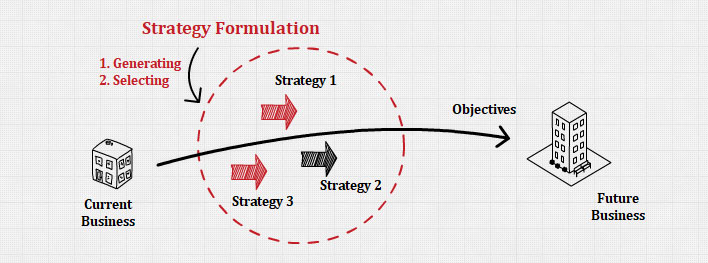
Business strategy formulation focuses on generating and evaluating alternative strategies, as well as selecting strategies to pursue.
Strategy formulation is concerned with the development of the organization’s mission, objectives, strategies, and policies.
This activity seeks to determine alternative courses of action that could best enable the firm to achieve its mission and objectives. The firm’s present strategies, objectives, and mission, coupled with the external and internal environment information, provide a basis for generating and evaluating feasible alternative strategies.
Alternative strategies are derived from the firm’s vision, mission, objectives, external environment scanning, and internal environment scanning. They are consistent with or build on, past strategies that have worked well.
Unless a desperate situation confronts the firm, alternative strategies will likely represent incremental steps that move the firm from its present position to a desired future position.
Management never considers all feasible alternatives that could benefit the firm because there are an infinite number of possible actions and an infinite number of ways to implement those actions. Therefore, a manageable set of the most attractive alternative strategies must be developed. The advantages, disadvantages, trade-offs, costs, and benefits of these strategies should be determined.
Review Organization Mission during Strategy Formulation
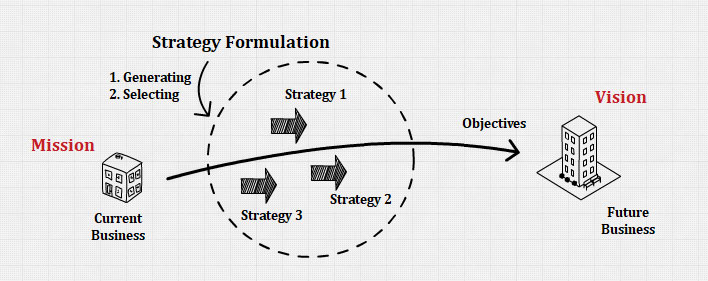
During strategy formulation, management often ends up selecting strategies that set the organization’s mission and objectives, rather than having choices incorporate clear objectives and mission statements.
This happens because the company tends to focus on the action possibilities, rather than on the mission to be fulfilled and objectives to be achieved.
Thus, when strategies are generated and alternative strategies are evaluated, it is critical to reexamine the current organization’s mission and objectives.
If a company mission is inappropriately stated, which may be too narrow or too broad, then the performance of the organization may suffer. If the mission statement does not provide a common thread for the entire business, management may not actually understand where the firm is heading. Objectives and strategies may be conflicted with each other, divisions and departments may be competing against one another, instead of outside competition.
If company objectives are inappropriately stated, they may either focus too much on short-term operational goals or be so general that it does not actually provide helpful guidelines. If strategies are carried on, there may be gaps between planned objectives and achieved objectives. When such a situation happens, either strategy needs to be adjusted, or objectives must be reviewed to be more realistic.
Process to Identify and Evaluate Strategies
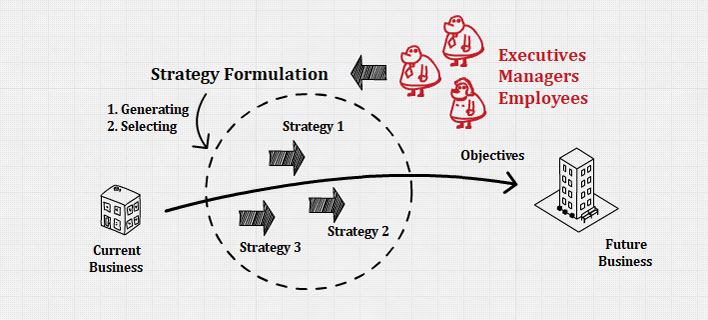
Identifying and evaluating alternative strategies should involve many of the managers, employees, and representatives from each department and division of the firm.
They are people who involve in earlier assembled the organizational vision and mission statements, performed the external environment scanning, and conducted the internal environment scanning.
All participants in the strategy analysis and choice activity should have the firm’s external and internal environment information by their sides. This information, coupled with the firm’s mission statement, will help participants crystallize in their own minds particular strategies that they believe could benefit the firm most.
Alternative strategies proposed by participants should be considered and discussed in a meeting or series of meetings.
Proposed strategies should be listed in writing. When all feasible strategies identified by participants are given and understood, the strategies should be ranked in order of attractiveness by all participants.
This process will result in a prioritized list of best strategies that reflect the collective wisdom of the group.
Management themselves, not analytic tools, are always responsible and accountable for strategic decisions. Management must be wary of this possibility and use analytical tools to facilitate, rather than to diminish communication. Without objective information and analysis, personal biases, politics, emotions, personalities, and halo error, unfortunately, may play a dominant role in the business strategy selection process.
Formulation Tool 1: SWOT Analysis
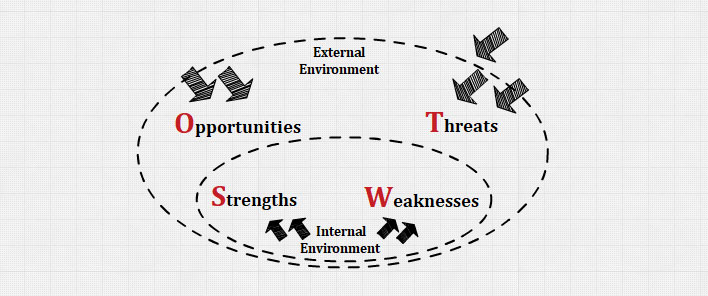
The process of strategy formulation begins with situation analysis, which is an activity to determine strategic fit between external opportunities and internal strengths while working around external threats and internal weaknesses.
One of the activities in situation analysis is to determine strategic factors, both in the external environment and internal organization. One of the types of analysis to find such factors is called SWOT analysis. SWOT analysis is a type of analysis to describe the particular strengths, weaknesses, opportunities, and threats that are strategic factors of a particular company.
SWOT analysis is not only resulted in the identification of the organization core competencies, which are the combination of specific resources and capabilities of the firm, but also in the identification of opportunities that the firm has not been able to take advantage of due to a lack of proper resources and capabilities.
Although the SWOT matrix is widely used in strategic planning, the analysis does have some limitations.
First, SWOT does not show how to achieve a competitive advantage, so it must not be an end in itself. The matrix should be the starting point for a discussion on how proposed strategies could be implemented as well as cost-benefit considerations that ultimately could lead to competitive advantage.
Second, SWOT is a static assessment (or snapshot) in time. A SWOT matrix can be like studying a single frame of a motion picture where you see the lead characters and the setting but have no clue as to the plot. As circumstances, capabilities, threats, and strategies change, the dynamics of a competitive environment may not be revealed in a single matrix.
Third, SWOT analysis may lead the firm to overemphasize a single internal or external factor in formulating strategies. There are interrelationships among the key internal and external factors that SWOT does not reveal that may be important in devising strategies.
One of the most relevant activities in the strategic formulation was to evaluate the strengths and weaknesses of an organization and identify the top trends in the external environment that are going to affect the firm in a specific timespan in the future. These trends represent opportunities and threats that by themselves have little value unless the organization has the required capabilities and resources, turn those into strength and use that strength to be able to take advantage of them.
The management of the organization’s weaknesses is as important as its strengths. This reflects important strategic issues that organizations must face, that whether the firm should invest more in strengths to make them even stronger, or whether the firm should invest in weaknesses to make them more competitive.
Formulation Tool 2: TWOS Matrix
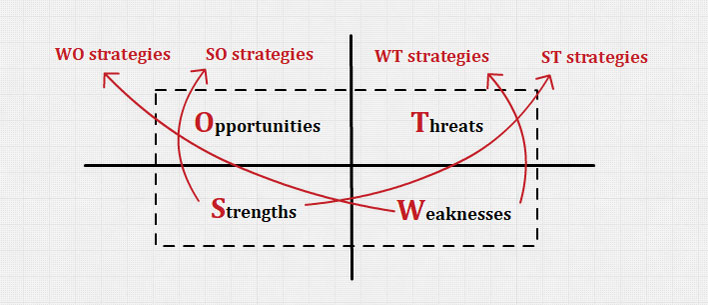
TOWS matrix describes how the external opportunities and threats facing the organization can be matched with internal strengths and weaknesses to result in 4 sets of possible strategic alternatives.
Using this matrix is a good way to brainstorm and create alternative strategies that might be missed otherwise. This tool can be used to generate business strategies as well as corporate strategies.
The 4 sets of possible alternative strategies are SO (strengths-opportunities) strategies, WO (weaknesses-opportunities) strategies, ST (strengths-threats) strategies, and WT (weaknesses-threats) strategies.
Alternative 1: SO Strategies
SO strategies use a firm’s internal strengths to take advantage of external opportunities. All managers would like their organizations to be in a position in which internal strengths can be used to take advantage of external trends and events.
Organizations generally will pursue WO, ST, or WT strategies to get into a situation in which they can apply SO strategies. When a firm has major weaknesses, it will strive to overcome them and make them strengths. When an organization faces major threats, it will seek to avoid them to concentrate on opportunities.
Alternative 2: ST Strategies
ST strategies use a firm’s strengths to avoid or reduce the impact of external threats. This, however, does not mean that a strong organization should always meet threats in the external environment head-on.
Alternative 3: WO Strategies
WO strategies aim at improving internal weaknesses by taking advantage of external opportunities. Sometimes key external opportunities exist, but a firm has internal weaknesses that prevent it from exploiting those opportunities.
Alternative 4: WT Strategies
WT strategies are defensive tactics directed at reducing internal weakness and avoiding external threats. An organization faced with numerous external threats and internal weaknesses may indeed be in a precarious position.
Formulation Tool 3: SPACE Matrix
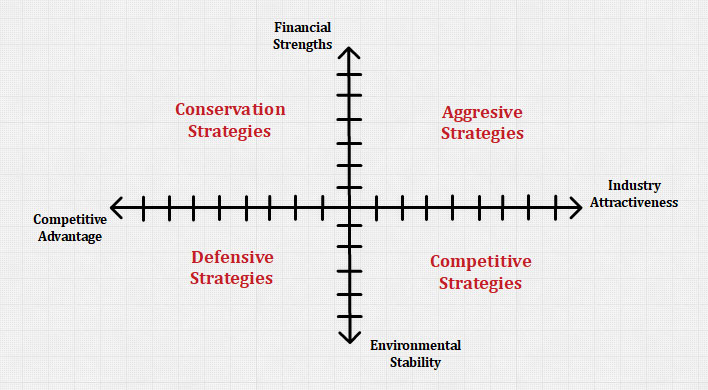
The Strategic Position and Action Evaluation (SPACE) Matrix indicates whether aggressive, conservative, defensive, or competitive strategies are most appropriate for a given organization.
The axes of the SPACE Matrix represent two internal dimensions (financial position [FP] and competitive position [CP]) and two external dimensions (stability position [SP] and industry position [IP]). These four factors are perhaps the most important determinants of an organization’s overall strategic position.
Depending on the type of organization, numerous variables could make up each of the dimensions represented on the axes of the SPACE Matrix. Like the SWOT Matrix, the SPACE Matrix should be both tailored to the particular organization being studied and based on factual information as much as possible.
Quadrant 1: Aggressive
When a firm’s directional vector is located in the aggressive quadrant (upper-right quadrant) of the SPACE Matrix, an organization is in an excellent position to use its internal strengths to (1) take advantage of external opportunities, (2) overcome internal weaknesses, and (3) avoid external threats.
Therefore, market penetration, market development, product development, backward integration, forward integration, horizontal integration, or diversification, can be feasible, depending on the specific circumstances that face the firm.
Quadrant 2: Conservative
The directional vector may appear in the conservative quadrant (upper-left quadrant) of the SPACE Matrix, which implies staying close to the firm’s basic competencies and not taking excessive risks.
Conservative strategies most often include market penetration, market development, product development, and related diversification.
Quadrant 3: Defensive
The directional vector may be located in the lower-left or defensive quadrant of the SPACE Matrix, which suggests that the firm should focus on rectifying internal weaknesses and avoiding external threats.
Defensive strategies include retrenchment, divestiture, liquidation, and related diversification.
Quadrant 4: Competitive
The directional vector may be located in the lower-right or competitive quadrant of the SPACE Matrix, indicating competitive strategies.
Competitive strategies include backward, forward, and horizontal integration; market penetration; market development, and product development.
Process to Create SPACE Matrix
The steps required to develop a SPACE Matrix are as follows:
Step 1: select a set of variables to define financial position (FP), competitive position (CP), stability position (SP), and industry position (IP).
Step 2: assign a numerical value ranging from +1 (worst) to +7 (best) to each of the variables that make up the FP and IP dimensions. Assign a numerical value ranging from -1 (best) to -7 (worst) to each of the variables that make up the SP and CP dimensions.
On the FP and CP axes, make a comparison to competitors. On the IP and SP axes, make a comparison to other industries.
Step 3: compute an average score for FP, CP, IP, and SP by summing the values given to the variables of each dimension and then by dividing by the number of variables included in the respective dimension.
Step 4: plot the average scores for FP, IP, SP, and CP on the appropriate axis in the SPACE Matrix.
Step 5: add the two scores on the x-axis and plot the resultant point on X. Add the two scores on the y-axis and plot the resultant point on Y. Plot the intersection of the new XY point.
Step 6: draw a directional vector from the origin of the SPACE Matrix through the new intersection point.
The directional vector associated with each profile suggests the type of strategies to pursue: aggressive, conservative, defensive, or competitive.
Resources
Further Reading
- Tips for Formulating a Successful Strategy (online.hbs.edu)
- Steps in Strategy Formulation (marketing91.com)
- Steps in Strategy Formulation Process (managementstudyguide.com)
- The Fundamentals of Strategy Formulation (cleverism.com)
- Strategy Formulation (referenceforbusiness.com)
- Strategy Formulation: Meaning, Aspects, Process, Approaches and Challenges (economicsdiscussion.net)
- Strategy Formulation: Develop the Basics for a Successful Strategy (trissaconsulting.com)
Related Concepts
References
- Hitt, M. A., Ireland, D. R., & Hoskisson, R. E. (2016). Strategic Management: Concepts: Competitiveness and Globalization (12th ed.). Cengage Learning.
- Hitt, M. A., Ireland, D. R., & Hoskisson, R. E. (2019). Strategic Management: Concepts and Cases: Competitiveness and Globalization (MindTap Course List) (13th ed.). Cengage Learning.